Synthesis of Polyaluminum Chloride Coagulant from Waste Aluminum Foil and Utilization in Petroleum Wastewater Treatment
Abstract
:1. Introduction
2. Materials and Methods
2.1. Materials
2.2. Synthesis of Poly Aluminum Chloride (PACl) Coagulant
2.3. Jar Test Coagulation Experiment
2.4. Characterization Instruments
3. Results and Discussion
3.1. Characterization Data
3.2. Effect of Operation Conditions on the PACl Coagulation Efficiency
3.2.1. Solution pH
3.2.2. PACl Coagulant Dosage
3.2.3. Solution Temperature
3.2.4. Jar Test Mixing Speed and Time
3.3. Application Case Study: Real PWW Effluent Treatment
4. Conclusions
Author Contributions
Funding
Data Availability Statement
Acknowledgments
Conflicts of Interest
References
- Karaman, C.; Karaman, O.; Show, P.L.; Orooji, Y.; Karimi-Maleh, H. Utilization of a double-cross-linked amino-functionalized three-dimensional graphene networks as a monolithic adsorbent for methyl orange removal: Equilibrium, kinetics, thermodynamics and artificial neural network modeling. Environ. Res. 2022, 207, 112156. [Google Scholar] [CrossRef] [PubMed]
- Patni, H.; Ragunathan, B. Recycling and Re-Usage of Oilfield Produced Water—A Review. Mater. Today Proc. 2023, 77, 307–313. [Google Scholar] [CrossRef]
- Younis, S.A.; Maitlo, H.A.; Lee, J.; Kim, K.H. Nanotechnology-Based Sorption and Membrane Technologies for the Treatment of Petroleum-Based Pollutants in Natural Ecosystems and Wastewater Streams. Adv. Colloid Interface Sci. 2020, 275, 102071. [Google Scholar] [CrossRef] [PubMed]
- Ghobashy, M.M.; Younis, S.A.; Elhady, M.A.; Serp, P. Radiation Induced In-Situ Cationic Polymerization of Polystyrene Organogel for Selective Absorption of Cholorophenols from Petrochemical Wastewater. J. Environ. Manag. 2018, 210, 307–315. [Google Scholar] [CrossRef]
- Zhao, C.; Zhou, J.; Yan, Y.; Yang, L.; Xing, G.; Li, H.; Wu, P.; Wang, M.; Zheng, H. Application of Coagulation/Flocculation in Oily Wastewater Treatment: A Review. Sci. Total Environ. 2021, 765, 142795. [Google Scholar] [CrossRef]
- Moremada, P.; Kalpage, S. Advances in Coagulation Technique for COD Removal of Petroleum Wastewater—A Review. In International Conference on Sustainable Built Environment; Springer: Berlin/Heidelberg, Germany, 2023; pp. 733–747. [Google Scholar]
- Malik, M.; Ibrahim, S.M.; Nazir, M.A.; Tahir, A.A.; Tufail, M.K.; Shah, S.S.A.; Anum, A.; Wattoo, M.A.; Rehman, A.U. Engineering of a Hybrid g-C3N4/ZnO-W/Cox Heterojunction Photocatalyst for the Removal of Methylene Blue Dye. Catalysts 2023, 13, 813. [Google Scholar] [CrossRef]
- Jiang, J.-Q. The Role of Coagulation in Water Treatment. Curr. Opin. Chem. Eng. 2015, 8, 36–44. [Google Scholar] [CrossRef]
- Wei, H.; Gao, B.; Ren, J.; Li, A.; Yang, H. Coagulation/Flocculation in Dewatering of Sludge: A Review. Water Res. 2018, 143, 608–631. [Google Scholar] [CrossRef]
- Jasmine, J.; Mukherji, S. Characterization of Oily Sludge from a Refinery and Biodegradability Assessment Using Various Hydrocarbon Degrading Strains and Reconstituted Consortia. J. Environ. Manag. 2015, 149, 118–125. [Google Scholar] [CrossRef]
- Aljuboury, D.; Palaniandy, P.; Abdul Aziz, H.B.; Feroz, S. Treatment of Petroleum Wastewater by Conventional and New Technologies-A Review. Glob. Nest J 2017, 19, 439–452. [Google Scholar]
- Lapointe, M.; Barbeau, B. Understanding the Roles and Characterizing the Intrinsic Properties of Synthetic vs. Natural Polymers to Improve Clarification through Interparticle Bridging: A Review. Sep. Purif. Technol. 2020, 231, 115893. [Google Scholar] [CrossRef]
- Lapointe, M.; Papineau, I.; Peldszus, S.; Peleato, N.; Barbeau, B. Identifying the Best Coagulant for Simultaneous Water Treatment Objectives: Interactions of Mononuclear and Polynuclear Aluminum Species with Different Natural Organic Matter Fractions. J. Water Process Eng. 2021, 40, 101829. [Google Scholar] [CrossRef]
- Wei, N.; Zhang, Z.; Liu, D.; Wu, Y.; Wang, J.; Wang, Q. Coagulation Behavior of Polyaluminum Chloride: Effects of PH and Coagulant Dosage. Chin. J. Chem. Eng. 2015, 23, 1041–1046. [Google Scholar] [CrossRef]
- Sudoh, R.; Islam, M.S.; Sazawa, K.; Okazaki, T.; Hata, N.; Taguchi, S.; Kuramitz, H. Removal of Dissolved Humic Acid from Water by Coagulation Method Using Polyaluminum Chloride (PAC) with Calcium Carbonate as Neutralizer and Coagulant Aid. J. Environ. Chem. Eng. 2015, 3, 770–774. [Google Scholar] [CrossRef]
- Zhang, Z.; Jing, R.; He, S.; Qian, J.; Zhang, K.; Ma, G.; Chang, X.; Zhang, M.; Li, Y. Coagulation of Low Temperature and Low Turbidity Water: Adjusting Basicity of Polyaluminum Chloride (PAC) and Using Chitosan as Coagulant Aid. Sep. Purif. Technol. 2018, 206, 131–139. [Google Scholar] [CrossRef]
- Chen, Y.; Matsui, Y.; Sato, T.; Shirasaki, N.; Matsushita, T. Overlooked Effect of Ordinary Inorganic Ions on Polyaluminum-Chloride Coagulation Treatment. Water Res. 2023, 235, 119909. [Google Scholar] [CrossRef]
- Satish Reddy, M.; Neeraja, D. Aluminum Residue Waste for Possible Utilisation as a Material: A Review. Sādhanā 2018, 43, 124. [Google Scholar] [CrossRef]
- Ghulam, N.A.; Abbas, M.N.; Sachit, D.E. Preparation of Synthetic Alumina from Aluminium Foil Waste and Investigation of Its Performance in the Removal of RG-19 Dye from Its Aqueous Solution. Indian Chem. Eng. 2020, 62, 301–313. [Google Scholar] [CrossRef]
- Gautam, M.; Pandey, B.; Agrawal, M. Carbon footprint of aluminum production: Emissions and mitigation. In Environmental Carbon Footprints; Butterworth-Heinemann: Oxford, UK, 2018; pp. 197–228. [Google Scholar] [CrossRef]
- Deena, H.; Khadeeja, P.; Leena, P.K.F.; Lekshmi, J.S.; Sreekumar, N. Production of Industrial Coagulant (Poly Aluminium Chloride) from Used Beverage Cans. J. Sci. Ind. Res. 2019, 78, 448–453. [Google Scholar]
- Srivastava, V.C.; Mall, I.D.; Mishra, I.M. Treatment of Pulp and Paper Mill Wastewaters with Poly Aluminium Chloride and Bagasse Fly Ash. Colloids Surf. A Physicochem. Eng. Asp. 2005, 260, 17–28. [Google Scholar] [CrossRef]
- Kong, Y.; Ma, Y.; Ding, L.; Ma, J.; Zhang, H.; Chen, Z.; Shen, J. Coagulation Behaviors of Aluminum Salts towards Humic Acid: Detailed Analysis of Aluminum Speciation and Transformation. Sep. Purif. Technol. 2021, 259, 118137. [Google Scholar] [CrossRef]
- Chen, W.; Li, B.; Li, Q.; Tian, J. Effect of Polyaluminum Chloride on the Properties and Hydration of Slag-Cement Paste. Constr. Build. Mater. 2016, 124, 1019–1027. [Google Scholar] [CrossRef]
- Zhuang, J.; Qi, Y.; Yang, H.; Li, H.; Shi, T. Preparation of Polyaluminum Zirconium Silicate Coagulant and Its Performance in Water Treatment. J. Water Process Eng. 2021, 41, 102023. [Google Scholar] [CrossRef]
- Zhou, F.S.; Hu, B.; Cui, B.L.; Liu, F.B.; Liu, F.; Wang, W.H.; Liu, Y.; Lu, R.R.; Hu, Y.M.; Zhang, Y.H.; et al. Preparation and Characteristics of Polyaluminium Chloride by Utilizing Fluorine-Containing Waste Acidic Mother Liquid from Clay-Brine Synthetic Cryolite Process. J. Chem. 2014, 2014, 274126. [Google Scholar] [CrossRef]
- Kloprogge, J.T.; Ruan, H.; Frost, R.L. Near-Infrared Spectroscopic Study of Basic Aluminum Sulfate and Nitrate. J. Mater. Sci. 2001, 36, 603–607. [Google Scholar] [CrossRef]
- Lal, K.; Garg, A. Physico-Chemical Treatment of Pulping Effluent: Characterization of Flocs and Sludge Generated after Treatment. Sep. Sci. Technol. 2017, 52, 1583–1593. [Google Scholar] [CrossRef]
- Tzoupanos, N.D.; Zouboulis, A.I.; Tsoleridis, C.A. A Systematic Study for the Characterization of a Novel Coagulant (Polyaluminium Silicate Chloride). Colloids Surf. A Physicochem. Eng. Asp. 2009, 342, 30–39. [Google Scholar] [CrossRef]
- Shoaib, A.G.M.; El-sikaily, A.; Nemr, A.E. Testing the Carbonization Condition for High Surface Area Preparation of Activated Carbon Following Type IV Green Alga Ulva Lactuca; Springer: Berlin/Heidelberg, Germany, 2022; pp. 3303–3318. [Google Scholar]
- Yurdakal, S.; Garlisi, C.; Özcan, L.; Bellardita, M.; Palmisano, G. (Photo)Catalyst Characterization Techniques: Adsorption Isotherms and BET, SEM, FTIR, UV-Vis, Photoluminescence, and Electrochemical Characterizations in Heterogeneous Photocatalysis; Elsevier: Amsterdam, The Netherlands, 2019; pp. 87–152. [Google Scholar] [CrossRef]
- Zhao, A.C.; Zhang, T.A.; Lv, G.Z. Thermodynamic Analysis of Nucleation during Pyrolysis Process of Aluminum Chloride Solution. MRS Commun. 2021, 11, 679–684. [Google Scholar] [CrossRef]
- Shi, B.; Wei, Q.; Wang, D.; Zhu, Z.; Tang, H. Coagulation of Humic Acid: The Performance of Preformed and Non-Preformed Al Species. Colloids Surf. A Physicochem. Eng. Asp. 2007, 296, 141–148. [Google Scholar] [CrossRef]
- Klimiuk, E.; Filipkowska, U.; Korzeniowska, A. Effects of PH and Coagulant Dosage on Effectiveness of Coagulation of Reactive Dyes from Model Wastewater by Polyaluminium Chloride (PAC). Pol. J. Environ. Stud. 1999, 8, 73–79. [Google Scholar]
- Liang, L.; Tan, J.; Peng, Y.; Xia, W.; Xie, G. The Role of Polyaluminum Chloride in Kaolinite Aggregation in the Sequent Coagulation and Flocculation Process. J. Colloid Interface Sci. 2016, 468, 57–61. [Google Scholar] [CrossRef] [PubMed]
- Wu, Z.; Zhang, X.; Pang, J.; Li, J.; Li, J.; Zhang, P. High-Poly-Aluminum Chloride Sulfate Coagulants and Their Coagulation Performances for Removal of Humic Acid. RSC Adv. 2020, 10, 7155–7162. [Google Scholar] [CrossRef] [PubMed]
- Wang, Z.; Peng, S.; Nan, J.; He, C.; Qi, F.; Ji, X.; Li, W.; Sun, D. Effect of Al Species of Polyaluminum Chlorides on Floc Breakage and Re-Growth Process: Dynamic Evolution of Floc Properties, Dissolved Organic Matter and Dissolved Al. Chemosphere 2020, 249, 126449. [Google Scholar] [CrossRef]
- Zand, A.D.; Hoveidi, H. Comparing Aluminium Sulfate and Poly-Aluminium Chloride (PAC) Performance in Turbidity Removal from Synthetic Water. J. Appl. Biotechnol. Rep. 2015, 2, 287–292. [Google Scholar]
- Pernitsky, D.J.; Edzwald, J.K. Selection of alum and polyaluminum coagulants: Principles and applications. J. Water Supply: Res. Technol.–AQUA 2006, 55, 121–141. [Google Scholar] [CrossRef]
- Zhan, X.; Gao, B.; Yue, Q.; Wang, Y.; Wang, Q. Coagulation Efficiency of Polyaluminum Chloride for Natural Organic Matter Removal from Low Specific UV Absorbance Surface Water and the Subsequent Effects on Chlorine Decay. Chem. Eng. J. 2010, 161, 60–67. [Google Scholar] [CrossRef]
- Abujazar, M.S.S.; Karaağaç, S.U.; Abu Amr, S.S.; Alazaiza, M.Y.D.; Bashir, M.J. Recent Advancement in the Application of Hybrid Coagulants in Coagulation-Flocculation of Wastewater: A Review. J. Clean. Prod. 2022, 345, 131133. [Google Scholar] [CrossRef]
- Deng, S.; Zhou, Q.; Yu, G.; Huang, J.; Fan, Q. Removal of Perfluorooctanoate from Surface Water by Polyaluminium Chloride Coagulation. Water Res. 2011, 45, 1774–1780. [Google Scholar] [CrossRef]
- Djeffal, K.; Bouranene, S.; Fievet, P.; Déon, S.; Gheid, A. Treatment of Controlled Discharge Leachate by Coagulation-Flocculation: Influence of Operational Conditions. Sep. Sci. Technol. 2021, 56, 168–183. [Google Scholar] [CrossRef]
- Wu, C.-D.; Xu, X.-J.; Liang, J.-L.; Wang, Q.; Dong, Q.; Liang, W.-L. Enhanced Coagulation for Treating Slightly Polluted Algae-Containing Surface Water Combining Polyaluminum Chloride (PAC) with Diatomite. Desalination 2011, 279, 140–145. [Google Scholar] [CrossRef]
- Mohammed, T.J.; Shakir, E. Effect of Settling Time, Velocity Gradient, and Camp Number on Turbidity Removal for Oilfield Produced Water. Egypt. J. Pet. 2018, 27, 31–36. [Google Scholar] [CrossRef]
- You, Z.; Xu, H.; Sun, Y.; Zhang, S.; Zhang, L. Effective Treatment of Emulsified Oil Wastewater by the Coagulation–Flotation Process. RSC Adv. 2018, 8, 40639–40646. [Google Scholar] [CrossRef]
- Nan, J.; Wang, Z.; Yao, M.; Yang, Y.; Zhang, X. Characterization of Re-Grown Floc Size and Structure: Effect of Mixing Conditions during Floc Growth, Breakage and Re-Growth Process. Environ. Sci. Pollut. Res. 2016, 23, 23750–23757. [Google Scholar] [CrossRef] [PubMed]
- Wang, Z.; Nan, J.; Yao, M.; Yang, Y. Effect of Additional Polyaluminum Chloride and Polyacrylamide on the Evolution of Floc Characteristics during Floc Breakage and Re-Growth Process. Sep. Purif. Technol. 2017, 173, 144–150. [Google Scholar] [CrossRef]


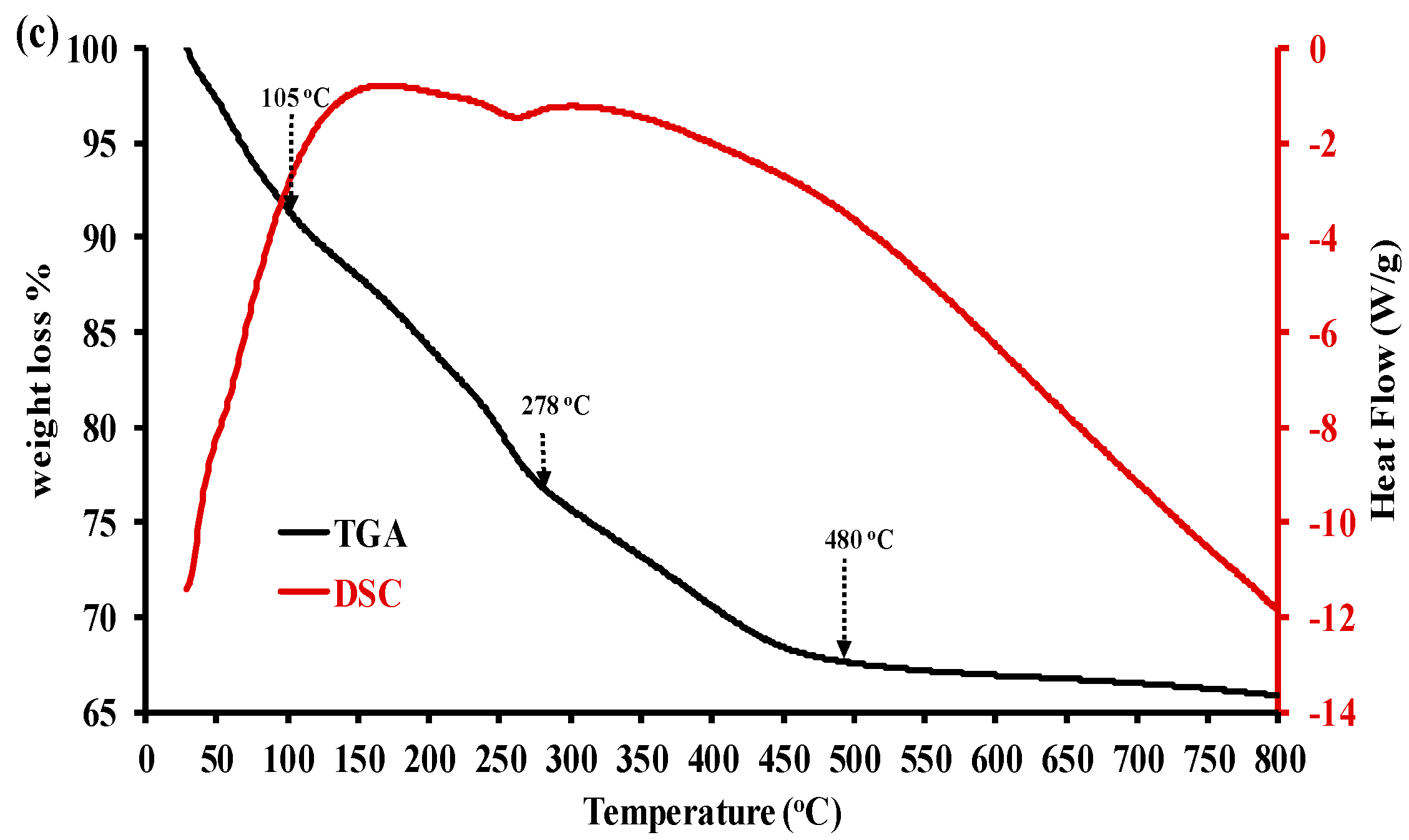
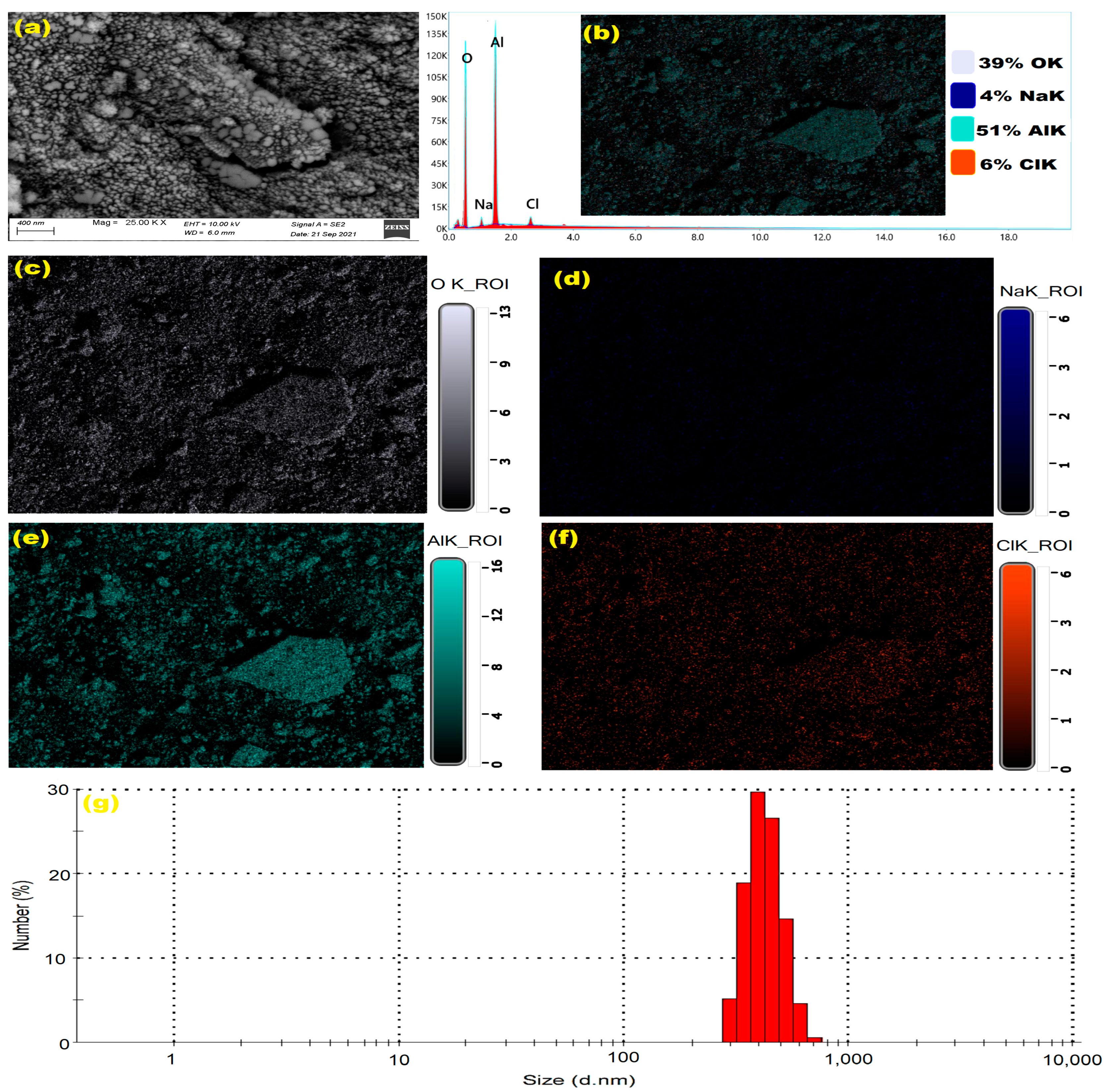

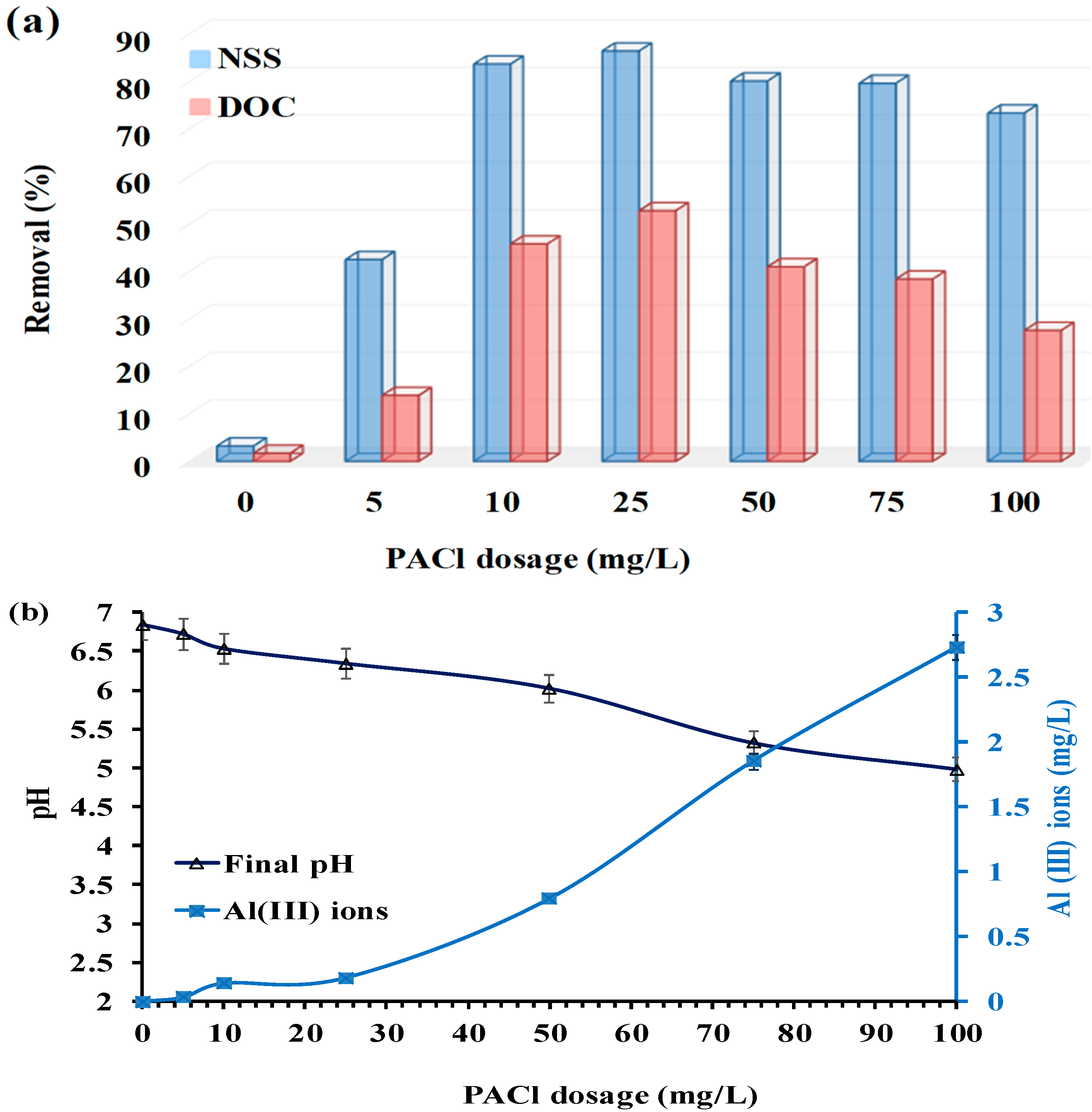
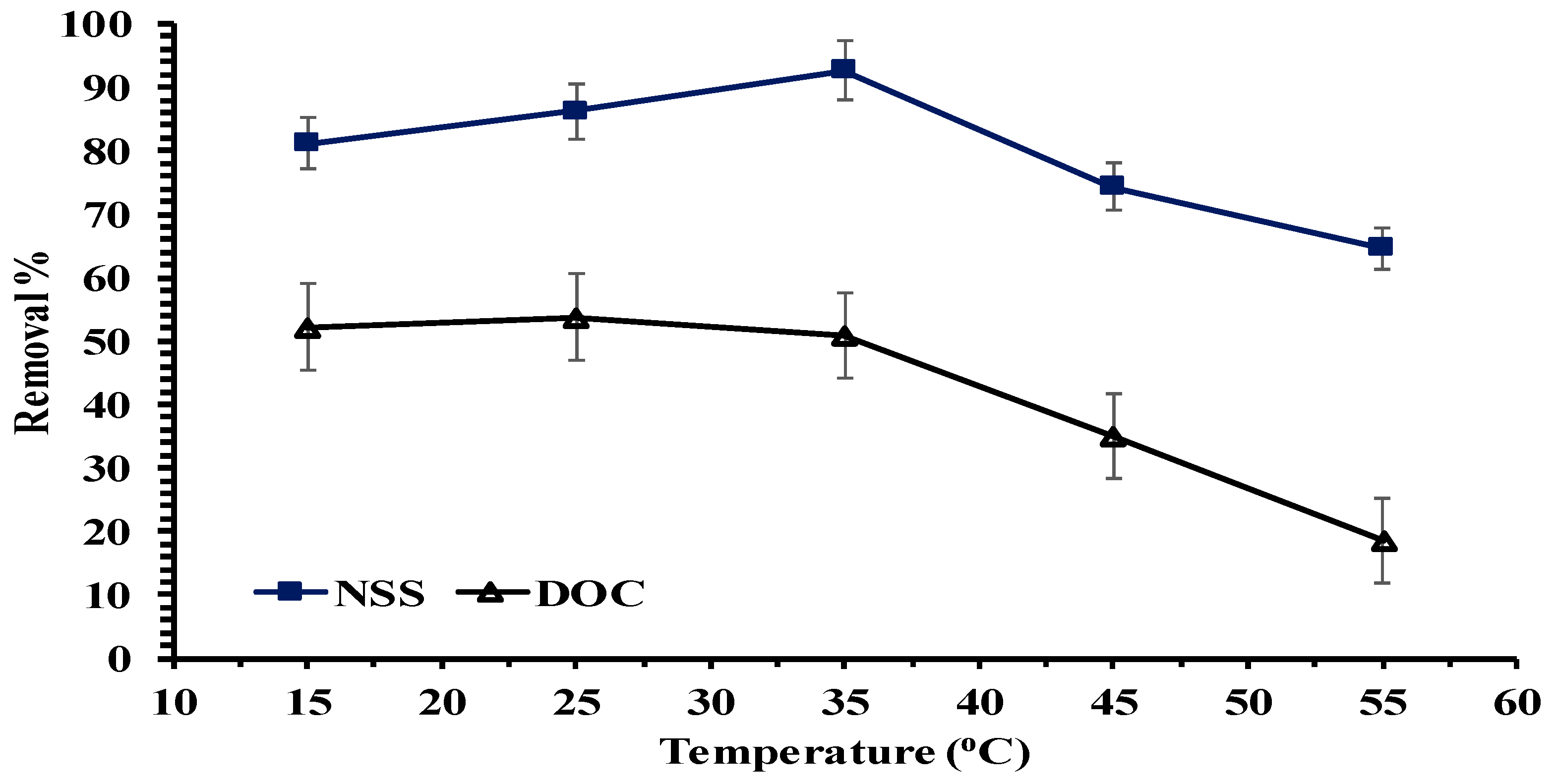
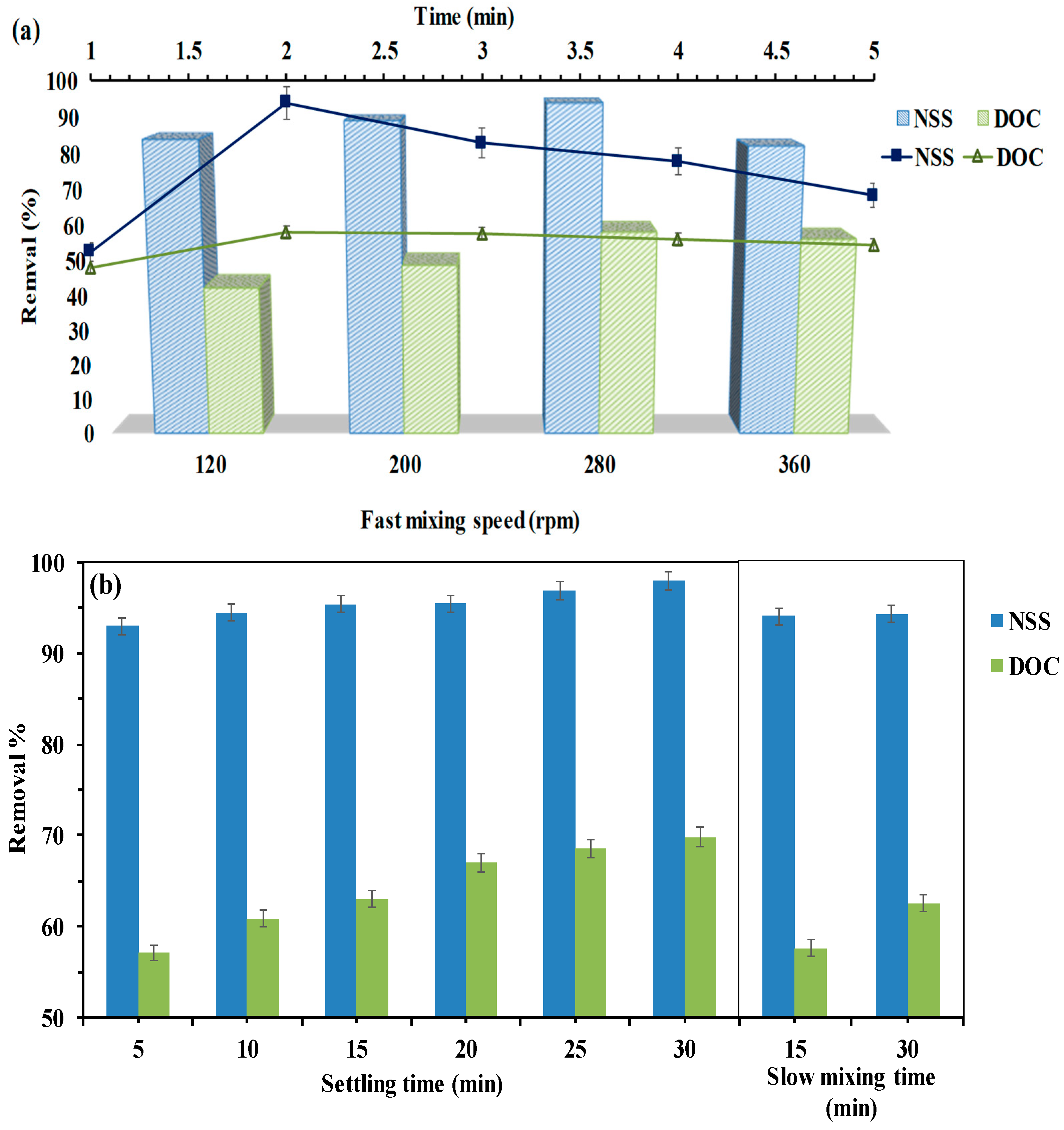
| Parameters | PWW-S1 | PWW-S2 | PWW-S3 | |||
|---|---|---|---|---|---|---|
| Raw | Treated | Raw | Treated | Raw | Treated | |
| pH | 6.56 | 5.47 | 7.12 | 5.93 | 6.85 | 5.74 |
| EC (mS/cm) | 218.5 | 211.3 | 128.2 | 124.5 | 28.3 | 27.8 |
| TDS (g/L) | 196.1 | 193.4 | 104.5 | 102.67 | 21.56 | 20.97 |
| Salinity (NaCl: g/L) | 187.7 | 185.3 | 98.76 | 97.56 | 16.89 | 16.52 |
| Hardness (CaCO3: mg/L) | 26.46 | 25.27 | 21.87 | 21.11 | 19.87 | 19.54 |
| Turbidity (NTU) | 330 | 81 (75.5%) | 248 | 47 (81.1%) | 88 | 9.2 (89.8%) |
| DOC (mg/L) | 285 | 92 (67.7%) | 117 | 36 (69.2%) | 54 | 17 (68.5%) |
Disclaimer/Publisher’s Note: The statements, opinions and data contained in all publications are solely those of the individual author(s) and contributor(s) and not of MDPI and/or the editor(s). MDPI and/or the editor(s) disclaim responsibility for any injury to people or property resulting from any ideas, methods, instructions or products referred to in the content. |
© 2023 by the authors. Licensee MDPI, Basel, Switzerland. This article is an open access article distributed under the terms and conditions of the Creative Commons Attribution (CC BY) license (https://creativecommons.org/licenses/by/4.0/).
Share and Cite
Youssef, H.H.; Younis, S.A.; El-Fawal, E.M.; Ali, H.R.; Moustafa, Y.M.; Mohamed, G.G. Synthesis of Polyaluminum Chloride Coagulant from Waste Aluminum Foil and Utilization in Petroleum Wastewater Treatment. Separations 2023, 10, 570. https://doi.org/10.3390/separations10110570
Youssef HH, Younis SA, El-Fawal EM, Ali HR, Moustafa YM, Mohamed GG. Synthesis of Polyaluminum Chloride Coagulant from Waste Aluminum Foil and Utilization in Petroleum Wastewater Treatment. Separations. 2023; 10(11):570. https://doi.org/10.3390/separations10110570
Chicago/Turabian StyleYoussef, Hanan H., Sherif A. Younis, Esraa M. El-Fawal, Hager R. Ali, Yasser M. Moustafa, and Gehad G. Mohamed. 2023. "Synthesis of Polyaluminum Chloride Coagulant from Waste Aluminum Foil and Utilization in Petroleum Wastewater Treatment" Separations 10, no. 11: 570. https://doi.org/10.3390/separations10110570
APA StyleYoussef, H. H., Younis, S. A., El-Fawal, E. M., Ali, H. R., Moustafa, Y. M., & Mohamed, G. G. (2023). Synthesis of Polyaluminum Chloride Coagulant from Waste Aluminum Foil and Utilization in Petroleum Wastewater Treatment. Separations, 10(11), 570. https://doi.org/10.3390/separations10110570







